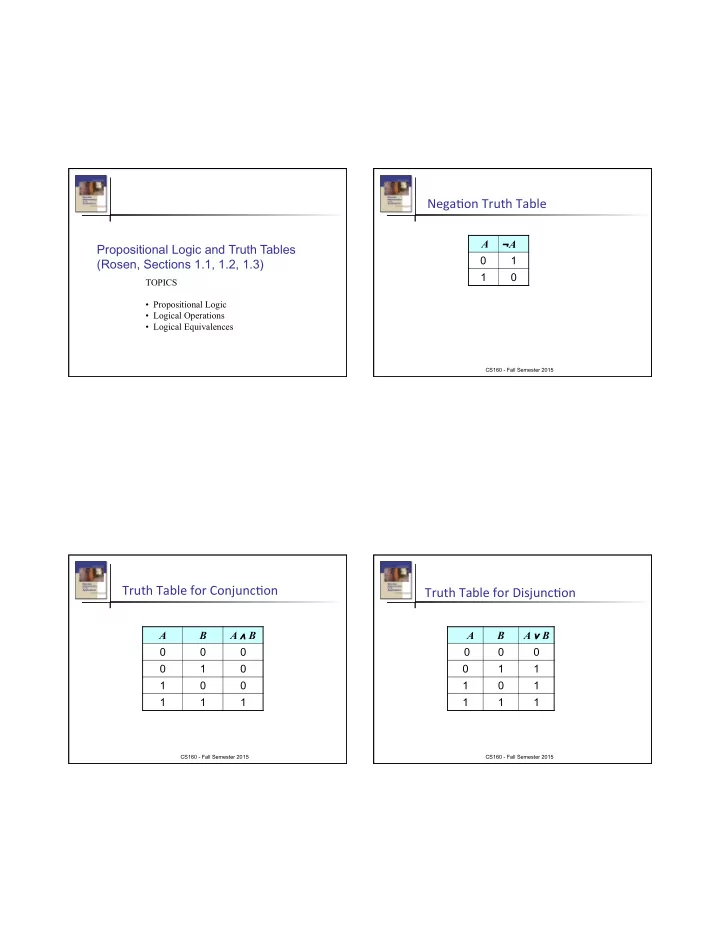

10/13/15 Nega%on ¡Truth ¡Table ¡ A ¬ A Propositional Logic and Truth Tables 0 1 (Rosen, Sections 1.1, 1.2, 1.3) 1 0 TOPICS • Propositional Logic • Logical Operations • Logical Equivalences CS160 - Fall Semester 2015 Truth ¡Table ¡for ¡Conjunc%on ¡ Truth ¡Table ¡for ¡Disjunc%on ¡ A B A ∧ B A B A ∨ B 0 0 0 0 0 0 0 1 0 0 1 1 1 0 0 1 0 1 1 1 1 1 1 1 CS160 - Fall Semester 2015 CS160 - Fall Semester 2015 1
10/13/15 Condi%onal ¡& ¡Bicondi%onal ¡ Implica%on ¡ Exclusive ¡Or ¡ n The ¡condi%onal ¡implica%on ¡connec%ve ¡is ¡ → n The ¡“or” ¡connec%ve ¡ ∨ ¡is ¡inclusive: ¡it ¡is ¡true ¡ if ¡either ¡ or ¡both ¡arguments ¡are ¡true ¡ n The ¡bicondi%onal ¡implica%on ¡connec%ve ¡is ¡ ↔ n These, ¡too, ¡are ¡defined ¡by ¡truth ¡tables ¡ n There ¡is ¡also ¡an ¡exclusive ¡or ¡ ⊕ A B A ⊕ B A B A → B A B A ↔ B 0 0 0 0 0 1 0 0 1 0 1 1 0 1 1 0 1 0 1 0 1 1 0 0 1 0 0 1 1 0 1 1 1 1 1 1 CS160 - Fall Semester 2015 CS160 - Fall Semester 2015 Compound ¡Truth ¡Tables ¡ Tautology and Contradiction n Truth ¡tables ¡can ¡also ¡be ¡used ¡to ¡determine ¡ n A tautology is a compound proposition that is the ¡truth ¡values ¡of ¡compound ¡statements, ¡ always true. such ¡as ¡(A ∨ B) ∧ ( ¬ A) ¡(fill ¡this ¡as ¡an ¡exercise) ¡ n A contradiction is a compound proposition that is always false. A B ¬ A A ∨ B (A ∨ B) ∧ ( ¬ A) n A contingency is neither a tautology nor a contradiction. 0 0 1 0 0 n A compound proposition is satisfiable if there is 0 1 1 1 1 at least one assignment of truth values to the variables that makes the statement true. 1 0 0 1 0 1 1 0 1 0 CS160 - Fall Semester 2015 CS160 - Fall Semester 2015 2
10/13/15 Logical Equivalence Prove ¬ (p ∧ q) ≡ ¬ p ∨ ¬ q n Two compound propositions, p and q, are p p q ¬ p ¬ q (p ∧ q) ¬ (p ∧ q) ¬ p ∨ ¬ q q logically equivalent if p ↔ q is a tautology. n Notation: p ≡ q 0 0 1 1 0 1 1 n De Morgan’s Laws: 0 1 1 0 0 1 1 ¬ (p ∧ q) ≡ ¬ p ∨ ¬ q ¬ (p ∨ q) ≡ ¬ p ∧ ¬ q 1 0 0 1 0 1 1 n How so? Let’s build a truth table! 1 1 0 0 1 0 0 = = CS160 - Fall Semester 2015 CS160 - Fall Semester 2015 Show ¬ (p ∨ q) ≡ ¬ p ∧ ¬ q More Equivalences p p q ¬ p ¬ q (p ∨ q) ¬ (p ∨ q) q Equivalence Name ¬ p ∧ ¬ q Identity p ∧ T ≡ p 0 0 1 1 0 1 1 p ∨ F ≡ p Commutative 0 1 1 0 1 0 0 p ∧ q ≡ q ∧ p p ∨ q ≡ q ∨ p 1 0 0 1 1 0 0 Absorption p ∨ (p ∧ q) ≡ p p ∧ (p ∨ q) ≡ p 1 1 0 0 1 0 0 See Rosen for more. = = CS160 - Fall Semester 2015 CS160 - Fall Semester 2015 3
10/13/15 Converse, Contrapositive, Inverse Logical Equivalences n The converse of an implication p → q n Show page of inference rules and reverses the propositions : q → p logical equivalences on course web site – ignore the inference rules for the n The inverse of an implication p → q inverts moment. both propositions: ¬ p → ¬ q n The contrapositive of an implication p → q reverses and inverts: ¬ q → ¬ p The converse and inverse are not logically equivalent to the original implication, but the contrapositive is, and may be easier to prove. CS160 - Fall Semester 2015 CS160 - Fall Semester 2015 Same proof using a truth table: Logical Equivalence Proof ¬ (p ∨ ( ¬ p ∧ q)) ≡ ¬ p ∧ ¬ q (Cannot use Inference Rules!) Prove: ¬ (p ∨ ( ¬ p ∧ q)) ≡ ¬ p ∧ ¬ q p q ¬ p ¬ q ¬ p ∧ q p ∨ ( ¬ p ∧ q) ¬ (p ∨ ( ¬ p ∧ q)) ¬ p ∧ ¬ q ¬ (p ∨ ( ¬ p ∧ q)) ≡ ¬ p ∧ ¬ ( ¬ p ∧ q) n By 2nd DeMorgan’s T T F F F T F F ≡ ¬ p ∧ ( ¬¬ p ∨ ¬ q) n By 1st DeMorgan’s T F F T F T F F ≡ ¬ p ∧ (p ∨ ¬ q) n By Double Negation ≡ ( ¬ p ∧ p) ∨ ( ¬ p ∧ ¬ q) n By 2 nd Distributive F T T F T T F F ≡ F ∨ ( ¬ p ∧ ¬ q) n By Negation Law F F T T F F T T ≡ ( ¬ p ∧ ¬ q) ∨ F n By Commutative Law ≡ ( ¬ p ∧ ¬ q) n By Identity Law = = CS160 - Fall Semester 2015 CS160 - Fall Semester 2015 4
Recommend
More recommend